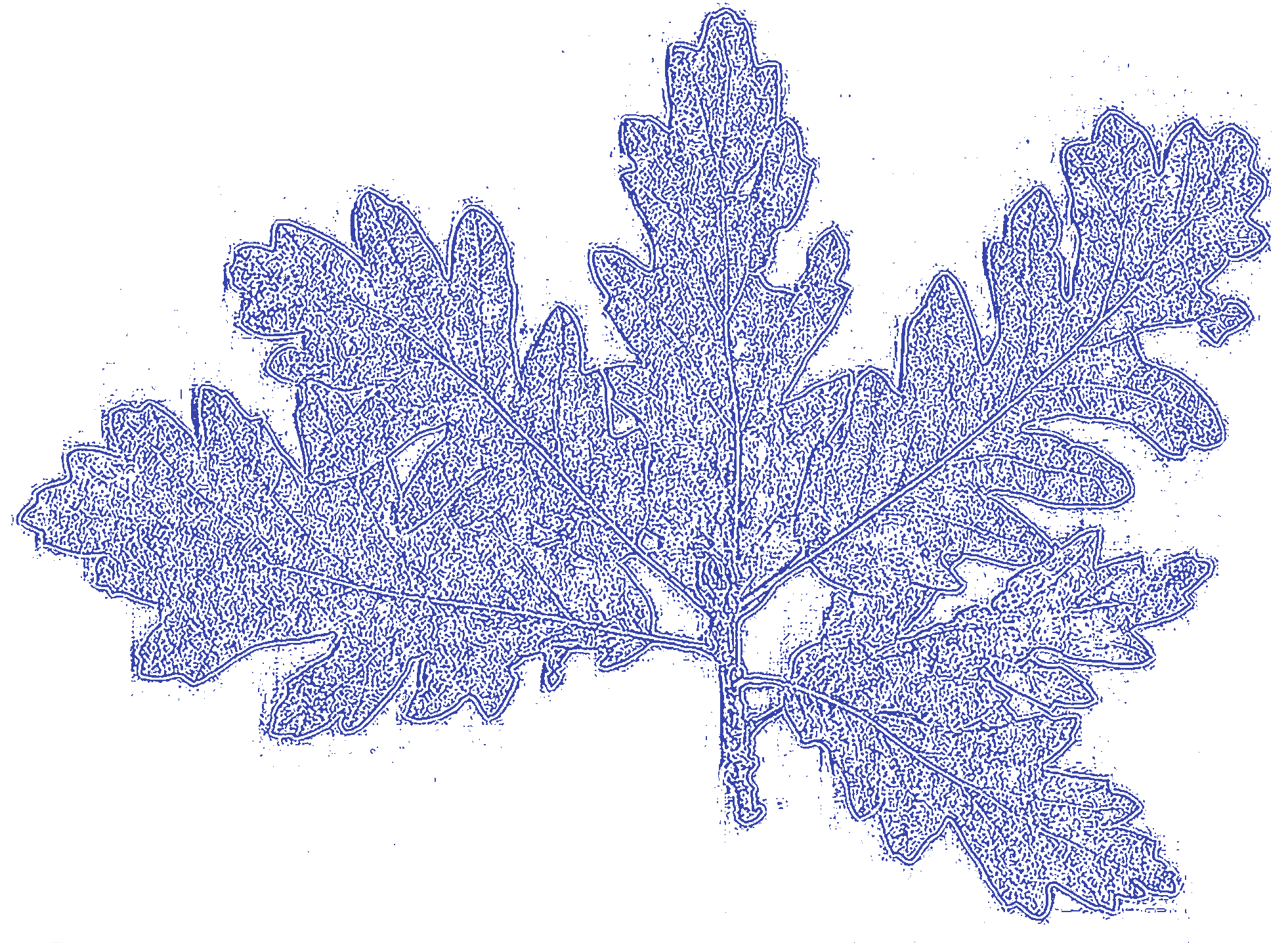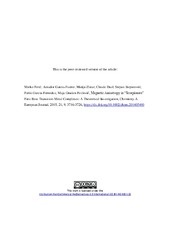Magnetic Anisotropy in "Scorpionate" First-Row Transition-Metal Complexes: A Theoretical Investigation
Аутори
Perić, Marko
Garcia-Fuente, Amador

Zlatar, Matija

Daul, Claude

Stepanović, Stepan

Garcia-Fernandez, Pablo

Gruden-Pavlović, Maja

Чланак у часопису (Рецензирана верзија)
Метаподаци
Приказ свих података о документуАпстракт
In this work we have analyzed in detail the magnetic anisotropy in a series of hydrotris(pyrazolyl)borate (Tp(-)) metal complexes, namely [VTpCl](+), [CrTpCl](+), [MnTpCl](+), [FeTpCl], [CoTpCl], and [NiTpCl], and their substituted methyl and tert-butyl analogues with the goal of observing the effect of the ligand field on the magnetic properties. In the [VTpCl](+), [CrTpCl](+), [CoTpCl], and [NiTpCl] complexes, the magnetic anisotropy arises as a consequence of out-of-state spin-orbit coupling, and covalent changes induced by the substitution of hydrogen atoms on the pyrazolyl rings does not lead to drastic changes in the magnetic anisotropy. On the other hand, much larger magnetic anisotropies were predicted in complexes displaying a degenerate ground state, namely [MnTpCl](+) and [FeTpCl], due to in-state spin-orbit coupling. The anisotropy in these systems was shown to be very sensitive to perturbations, for example, chemical substitution and distortions due to the Jahn-Teller effe...ct. We found that by substituting the hydrogen atoms in [MnTpCl](+) and [FeTpCl] by methyl and tert-butyl groups, certain covalent contributions to the magnetic anisotropy energy (MAE) could be controlled, thereby achieving higher values. Moreover, we showed that the selection of ion has important consequences for the symmetry of the ground spin-orbit term, opening the possibility of achieving zero magnetic tunneling even in non-Kramers ions. We have also shown that substitution may also contribute to a quenching of the Jahn-Teller effect, which could significantly reduce the magnetic anisotropy of the complexes studied.
Кључне речи:
density functional calculations / Jahn-Teller distortion / ligand-field effects / magnetic properties / scorpionate complexesИзвор:
Chemistry-A European Journal, 2015, 21, 9, 3716-3726Издавач:
- Wiley-VCH Verlag Gmbh, Weinheim
Финансирање / пројекти:
- Рационални дизајн и синтеза биолошки активних и координационих једињења и функционалних материјала, релевантних у (био)нанотехнологији (RS-MESTD-Basic Research (BR or ON)-172035)
- Swiss State Secretariat for Research and Innovation
- Ramon y Cajal programme [RYC-2013-12515]
- COST Action [CM1305, CM1006]
- Spanish Ministerio of Economia y Competitividad [FIS2012-37549-C05-4]
- Swiss National Science Foundation
Напомена:
- This is peer-reviewed version of the article: https://10.1002/chem.201405480
- http://cer.ihtm.bg.ac.rs/handle/123456789/1730
DOI: 10.1002/chem.201405480
ISSN: 0947-6539
PubMed: 25591004
WoS: 000350116200028
Scopus: 2-s2.0-84923044611
Институција/група
IHTMTY - JOUR AU - Perić, Marko AU - Garcia-Fuente, Amador AU - Zlatar, Matija AU - Daul, Claude AU - Stepanović, Stepan AU - Garcia-Fernandez, Pablo AU - Gruden-Pavlović, Maja PY - 2015 UR - https://cer.ihtm.bg.ac.rs/handle/123456789/2911 AB - In this work we have analyzed in detail the magnetic anisotropy in a series of hydrotris(pyrazolyl)borate (Tp(-)) metal complexes, namely [VTpCl](+), [CrTpCl](+), [MnTpCl](+), [FeTpCl], [CoTpCl], and [NiTpCl], and their substituted methyl and tert-butyl analogues with the goal of observing the effect of the ligand field on the magnetic properties. In the [VTpCl](+), [CrTpCl](+), [CoTpCl], and [NiTpCl] complexes, the magnetic anisotropy arises as a consequence of out-of-state spin-orbit coupling, and covalent changes induced by the substitution of hydrogen atoms on the pyrazolyl rings does not lead to drastic changes in the magnetic anisotropy. On the other hand, much larger magnetic anisotropies were predicted in complexes displaying a degenerate ground state, namely [MnTpCl](+) and [FeTpCl], due to in-state spin-orbit coupling. The anisotropy in these systems was shown to be very sensitive to perturbations, for example, chemical substitution and distortions due to the Jahn-Teller effect. We found that by substituting the hydrogen atoms in [MnTpCl](+) and [FeTpCl] by methyl and tert-butyl groups, certain covalent contributions to the magnetic anisotropy energy (MAE) could be controlled, thereby achieving higher values. Moreover, we showed that the selection of ion has important consequences for the symmetry of the ground spin-orbit term, opening the possibility of achieving zero magnetic tunneling even in non-Kramers ions. We have also shown that substitution may also contribute to a quenching of the Jahn-Teller effect, which could significantly reduce the magnetic anisotropy of the complexes studied. PB - Wiley-VCH Verlag Gmbh, Weinheim T2 - Chemistry-A European Journal T1 - Magnetic Anisotropy in "Scorpionate" First-Row Transition-Metal Complexes: A Theoretical Investigation VL - 21 IS - 9 SP - 3716 EP - 3726 DO - 10.1002/chem.201405480 ER -
@article{
author = "Perić, Marko and Garcia-Fuente, Amador and Zlatar, Matija and Daul, Claude and Stepanović, Stepan and Garcia-Fernandez, Pablo and Gruden-Pavlović, Maja",
year = "2015",
abstract = "In this work we have analyzed in detail the magnetic anisotropy in a series of hydrotris(pyrazolyl)borate (Tp(-)) metal complexes, namely [VTpCl](+), [CrTpCl](+), [MnTpCl](+), [FeTpCl], [CoTpCl], and [NiTpCl], and their substituted methyl and tert-butyl analogues with the goal of observing the effect of the ligand field on the magnetic properties. In the [VTpCl](+), [CrTpCl](+), [CoTpCl], and [NiTpCl] complexes, the magnetic anisotropy arises as a consequence of out-of-state spin-orbit coupling, and covalent changes induced by the substitution of hydrogen atoms on the pyrazolyl rings does not lead to drastic changes in the magnetic anisotropy. On the other hand, much larger magnetic anisotropies were predicted in complexes displaying a degenerate ground state, namely [MnTpCl](+) and [FeTpCl], due to in-state spin-orbit coupling. The anisotropy in these systems was shown to be very sensitive to perturbations, for example, chemical substitution and distortions due to the Jahn-Teller effect. We found that by substituting the hydrogen atoms in [MnTpCl](+) and [FeTpCl] by methyl and tert-butyl groups, certain covalent contributions to the magnetic anisotropy energy (MAE) could be controlled, thereby achieving higher values. Moreover, we showed that the selection of ion has important consequences for the symmetry of the ground spin-orbit term, opening the possibility of achieving zero magnetic tunneling even in non-Kramers ions. We have also shown that substitution may also contribute to a quenching of the Jahn-Teller effect, which could significantly reduce the magnetic anisotropy of the complexes studied.",
publisher = "Wiley-VCH Verlag Gmbh, Weinheim",
journal = "Chemistry-A European Journal",
title = "Magnetic Anisotropy in "Scorpionate" First-Row Transition-Metal Complexes: A Theoretical Investigation",
volume = "21",
number = "9",
pages = "3716-3726",
doi = "10.1002/chem.201405480"
}
Perić, M., Garcia-Fuente, A., Zlatar, M., Daul, C., Stepanović, S., Garcia-Fernandez, P.,& Gruden-Pavlović, M.. (2015). Magnetic Anisotropy in "Scorpionate" First-Row Transition-Metal Complexes: A Theoretical Investigation. in Chemistry-A European Journal Wiley-VCH Verlag Gmbh, Weinheim., 21(9), 3716-3726. https://doi.org/10.1002/chem.201405480
Perić M, Garcia-Fuente A, Zlatar M, Daul C, Stepanović S, Garcia-Fernandez P, Gruden-Pavlović M. Magnetic Anisotropy in "Scorpionate" First-Row Transition-Metal Complexes: A Theoretical Investigation. in Chemistry-A European Journal. 2015;21(9):3716-3726. doi:10.1002/chem.201405480 .
Perić, Marko, Garcia-Fuente, Amador, Zlatar, Matija, Daul, Claude, Stepanović, Stepan, Garcia-Fernandez, Pablo, Gruden-Pavlović, Maja, "Magnetic Anisotropy in "Scorpionate" First-Row Transition-Metal Complexes: A Theoretical Investigation" in Chemistry-A European Journal, 21, no. 9 (2015):3716-3726, https://doi.org/10.1002/chem.201405480 . .



